 A Brazilian company has forged a software bridge between Asterisk and Skype.
A Brazilian company has forged a software bridge between Asterisk and Skype.
Asterisk is an open source VoIP PBX that runs on Linux and other platforms which handles VoIP to VoIP calling as well as calls to landlines. Developed by Mark Spencer it has taken the community by storm, sprouting many tens of thousands of installations world-wide, with a thriving development community.
It can work with traditional telephony systems or POTS (plain old telephone system), with digital systems (ISDN etc) and modern VoIP protocols such as H.323, SIP, MGCP and more.
Digium (set-up by Spencer) now manufactures hardware and offers a commercially supported version of Asterisk known as ABE (Asterisk Binary Edition).
 One feature that has been missing is Skype integration (the next version of Asterisk v1.4 supports GoogleTalk using Google’s libjingle library). A Brazilian company has now changed that, with their ChanSkype site.
One feature that has been missing is Skype integration (the next version of Asterisk v1.4 supports GoogleTalk using Google’s libjingle library). A Brazilian company has now changed that, with their ChanSkype site.
ChanSkype
Currently the service is in test and you have to utilise ChanSkype’s own Asterisk servers. They offer a “free” trial whereby they allow a SIP connection and then by passing in a Skype address it sets-up a connection to the Skype user.
In the future they will be offering an actual chan_skype that plugs directly into any Asterisk server and can connect to the Skype network.
Of course it’s not quite so simple. The initial release only runs on RedHat’s Fedora Core or CentOS (which means it will probably also run on RedHat Enterprise Server too as CentOS is a clone of that). There must also be an X server running as well as the Skype for Linux client. So ChanSkype just bridges the two systems together.
A dual Xeon 3Ghz with 2 gigs of memory should run 30 simultaneous Skype calls without any noticable degradation of performance.
Pricing has not yet been set, but it will be licensed on a per-channel basis.
There may be licensing problems too as Asterisk modules should normally be available under a GPL license and with source code, but as Skype is proprietry they may get away with it.
Someone really needs to reverse engineer the Skype protocol and then a native chan_skype could be developed, but this is unlikely to happen in the western world as that could be illegal.
It’s a good idea, but really just a straight link into the Skype software which unfortunately is the only way it can be done.
 CSR, a chipset design lab in Cambridge that specialises in radio, has released a voice over WiFi design (UniVox) which a bill of materials of around £11.00.
CSR, a chipset design lab in Cambridge that specialises in radio, has released a voice over WiFi design (UniVox) which a bill of materials of around £11.00. Both SIP (version 2) and IAX2 (Inter Asterisk Protocol v2) are supported. IAX is useful in NAT environments as it can traverse NAT without any special software, while SIP can be a complete headache.
Both SIP (version 2) and IAX2 (Inter Asterisk Protocol v2) are supported. IAX is useful in NAT environments as it can traverse NAT without any special software, while SIP can be a complete headache. YouTube is continuing to get attention for the content it has on it. Not this time for alleged copyright violations, but for a young girl who has been appearing in videos about the trial and tribulations of her life. Her moniker?
YouTube is continuing to get attention for the content it has on it. Not this time for alleged copyright violations, but for a young girl who has been appearing in videos about the trial and tribulations of her life. Her moniker?  What raised our suspicions? It had always been shot on a video camera, high above a standard Web cam and edited in a self-consciously amateur fashion. The subjects she spoke about appeared just too ideal for the majority-male YouTube – geeky with relationship questions. Of course she was also very attractive. It was also strange that the music that was used in the tracks was always fully credited. We wondered if Bree was eventually going to start talking about products.
What raised our suspicions? It had always been shot on a video camera, high above a standard Web cam and edited in a self-consciously amateur fashion. The subjects she spoke about appeared just too ideal for the majority-male YouTube – geeky with relationship questions. Of course she was also very attractive. It was also strange that the music that was used in the tracks was always fully credited. We wondered if Bree was eventually going to start talking about products. It appears that some people who it also didn’t quite ring true for,
It appears that some people who it also didn’t quite ring true for, 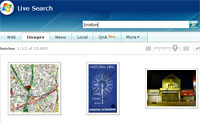 Microsoft is officially launching its updated next-gen, ‘Live Search’, search engine today as the company tries hard to catch up with market leaders Google and Yahoo.
Microsoft is officially launching its updated next-gen, ‘Live Search’, search engine today as the company tries hard to catch up with market leaders Google and Yahoo.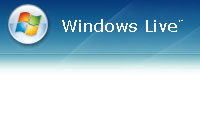 In line with its rivals, Live Search will also feature a new social search service called QnA, where surfers can pose questions and get answers from other users.
In line with its rivals, Live Search will also feature a new social search service called QnA, where surfers can pose questions and get answers from other users. Microsoft’s new search engine – with its Google-a-like super-simple homepage – has been in public beta testing since March at Live.com, which is also shaking off its beta status this week.
Microsoft’s new search engine – with its Google-a-like super-simple homepage – has been in public beta testing since March at Live.com, which is also shaking off its beta status this week.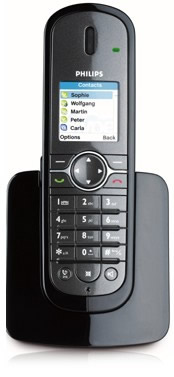 The news that OFCOM is to review its position on Voice Over IP services (VOIP) – the way we can make low cost or free phone and video calls currently from our PC’s generally using call centre-type headsets – is part of the evolution of these types of service from guerrilla geek to middle class mainstream. Now that Tesco’s are marketing VOIP services it’s fair to say that it’s a ‘regular’ service/product.
The news that OFCOM is to review its position on Voice Over IP services (VOIP) – the way we can make low cost or free phone and video calls currently from our PC’s generally using call centre-type headsets – is part of the evolution of these types of service from guerrilla geek to middle class mainstream. Now that Tesco’s are marketing VOIP services it’s fair to say that it’s a ‘regular’ service/product. Prices for the new device are not yet released, but industry observers are talking of a figure around a £100 to make this potentially cost saving purchase.
Prices for the new device are not yet released, but industry observers are talking of a figure around a £100 to make this potentially cost saving purchase.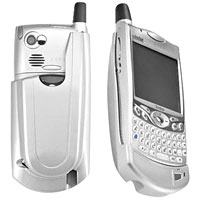 Although we’re not alone in thinking that the Palm Treo is the best smartphone around, the device suffers from one tragic omission; Wi-Fi.
Although we’re not alone in thinking that the Palm Treo is the best smartphone around, the device suffers from one tragic omission; Wi-Fi.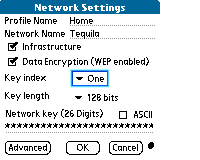 This design has obvious advantages and disadvantages; the advantage is that the sled offers its own power supply, giving users a considerably enhanced battery life compared to handheld-powered Wi-Fi cards; the disadvantage is that the thing adds bulk to the phone.
This design has obvious advantages and disadvantages; the advantage is that the sled offers its own power supply, giving users a considerably enhanced battery life compared to handheld-powered Wi-Fi cards; the disadvantage is that the thing adds bulk to the phone.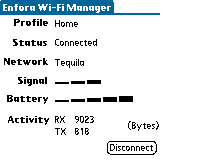 The unit must be charged for two hours before use, with a small amber LED blinking while charging. This turns to solid green when the Treo is connected to a Wi-Fi network.
The unit must be charged for two hours before use, with a small amber LED blinking while charging. This turns to solid green when the Treo is connected to a Wi-Fi network.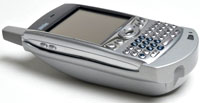 The first few times we tried this, it took so much effort to pull the phone in and out of the sled we began to fear we’d end up breaking the thing.
The first few times we tried this, it took so much effort to pull the phone in and out of the sled we began to fear we’d end up breaking the thing.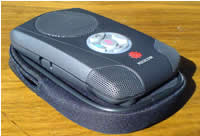 The Polycom Communicator (C100S) first caught our eye at the Skype-day in London. It’s a well-formed handsfree speaker/mic kit that connects to your PC via USB, letting you make trouble-free calls on Skype.
The Polycom Communicator (C100S) first caught our eye at the Skype-day in London. It’s a well-formed handsfree speaker/mic kit that connects to your PC via USB, letting you make trouble-free calls on Skype.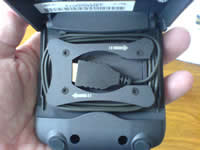 What’s it like to use
What’s it like to use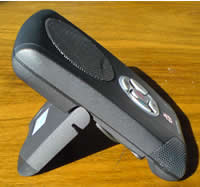 Design
Design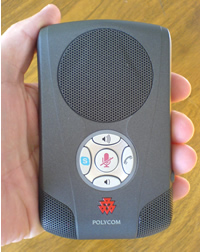 The centre-top is dominated by a high quality (22 KHz) speaker, with twin microphones on either side of the bottom front corners. This not only gives excellent sound reproduction (actually beyond Skype 16KHz capabilities), but the dual mics make it easy for many people around a table to take part in the conversation. The microphones are independently balanced, so a person sitting a distance away from one would not be drowned out by another sitting close to the other.
The centre-top is dominated by a high quality (22 KHz) speaker, with twin microphones on either side of the bottom front corners. This not only gives excellent sound reproduction (actually beyond Skype 16KHz capabilities), but the dual mics make it easy for many people around a table to take part in the conversation. The microphones are independently balanced, so a person sitting a distance away from one would not be drowned out by another sitting close to the other.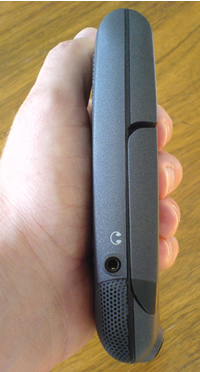 Around these buttons is a circular LED that gives progress on the call – it flashes green when connecting the call, glows green when on a call and red when the conversation is muted.
Around these buttons is a circular LED that gives progress on the call – it flashes green when connecting the call, glows green when on a call and red when the conversation is muted. A visual communications company, All New Video, have announced a deal with BBC to enable feedback and input into TV programmes from viewers, video calling from 3G phones, Web cams and ISDN. On the voice side, it will add VoIP to its inbound voice channels.
A visual communications company, All New Video, have announced a deal with BBC to enable feedback and input into TV programmes from viewers, video calling from 3G phones, Web cams and ISDN. On the voice side, it will add VoIP to its inbound voice channels. The system give the assistant producer the ability to carry out a video chat with the viewer letting them ascertain their suitability of the show – frankly, filter out those not relevant. Each person can also be ranked and some notes made about them.
The system give the assistant producer the ability to carry out a video chat with the viewer letting them ascertain their suitability of the show – frankly, filter out those not relevant. Each person can also be ranked and some notes made about them.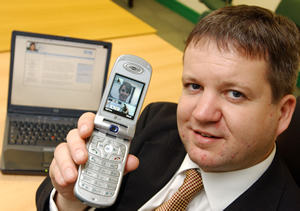 The new BBC system will let people do the same from the safety of their own bedrooms, where they’ll be able to leave their five minutes of video wisdom in a video mail system.
The new BBC system will let people do the same from the safety of their own bedrooms, where they’ll be able to leave their five minutes of video wisdom in a video mail system. Sony has released details of the Mylo, a groovy new Wi Fi-enabled personal communications device aimed at Instant Messaging nutters.
Sony has released details of the Mylo, a groovy new Wi Fi-enabled personal communications device aimed at Instant Messaging nutters.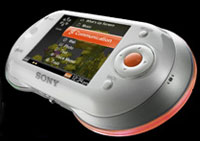 For teens who, like, don’t find email too slow for their hyperactive needs, there’s also an e-mail client, compatible with services such as Yahoo! Mail and the Gmail web mail service.
For teens who, like, don’t find email too slow for their hyperactive needs, there’s also an e-mail client, compatible with services such as Yahoo! Mail and the Gmail web mail service.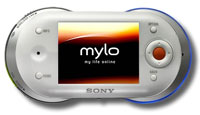 Battery life looks pretty good too, with a claimed 45 hours of music playback and around seven hours of instant-message chatting/Web surfing.
Battery life looks pretty good too, with a claimed 45 hours of music playback and around seven hours of instant-message chatting/Web surfing.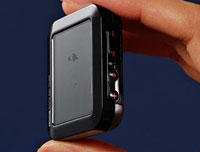 When it comes to convergence, we’re always on the look out for shiny new smartypants devices, even if we’re not always totally convinced about their usefulness.
When it comes to convergence, we’re always on the look out for shiny new smartypants devices, even if we’re not always totally convinced about their usefulness.